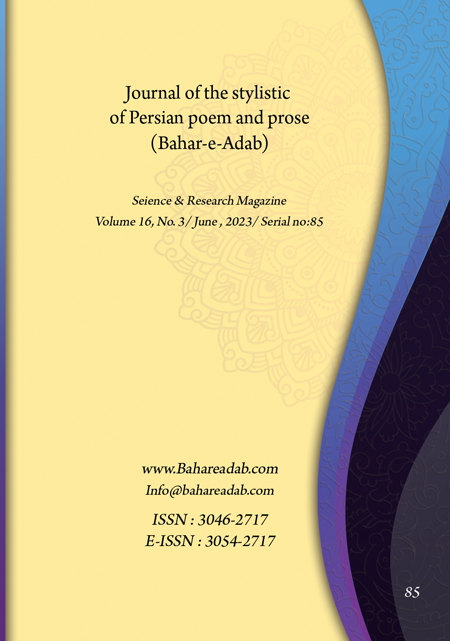- Count View : 212
- آدرس کوتاه شده مقاله: https://bahareadab.com/article_id/1454
- کد doi مقاله: Doi: 10.22034/bahareadab.2023 .16 .6776
Journal of the stylistic of Persian poem and prose
volume Number 16،
number In Volume 3،
،
issue Number 85
Investigating and analyzing the layer of description in the boasting and arrogance of Garshasbnameh and Banoogoshasbnameh; Based on Norman Fairclough's theory of critical discourse analysis
Farhanaz Jalali Ghasempour , Reza Ashrafzadeh (Author in Charge), Batul Fakhr Islam
Abstract
BACKGROUND AND OBJECTIVES: Asadi"s Garshasbnameh and Banoogoshasbnameh should be considered as important epic works in Persian language. Although the dominant approach in these two works is epic, the reflection of emotional components that are linked to the basics of lyrical literature is well highlighted. Singing and boasting are among the examples of lyrical components that Pahlavan uses to meet his various goals. The purpose of the present research is that by applying the theoretical foundations of Fairclough"s critical discourse analysis, the level of description in these brags and boasts has been represented in order to explore the various dimensions of these military tactics. The main question of the research is, what is the effect of boasting and boasting in the mentioned works in the representation of the discourse of "power" and in what discourse components has this category appeared?
METHODOLOGY: This research was done based on library sources and descriptive-analytical method.
FINDINGS: Words are used in brags and jokes to start a psychological war by the wrestlers. Also, the words in the mentioned works show the approach of "shepherd and lamb" in the discourses proposed by the characters. In connection with the characters, by describing a series of actions and emphasizing their physical abilities, the wrestlers show the gap between the singer and the other person as high as possible. At the level of association, the commonality of word networks in multiple phrases and sentences is an extension of power hegemony. Pronouns in these systems have played a role in reflecting the hierarchy governing interpersonal and social relations. The form of the verbs in boasting and arrogance is often news, which indicates the certainty of the issues raised. Also, authoritarianism is one of the important messages obtained by analyzing verbs.
CONCLUSION: The analysis of idioms and boasting in the mentioned works at the level of description shows a conscious confrontation by the singers in introducing the characters. Also, alienation between the discourses of the parties is clearly seen.
Keyword
Garshasbnameh
, Banoogoshasbnameh
, boasting and arrogance
, Critical Discourse Analysis
, Fairclough
, Power.
- Aghagolzadeh, F. (2012). Descriptive culture of discourse analysis and pragmatics. Tehran: Elmi & Farhangi, p.80.
- Aghagolzadeh, F. and Dehghan, M. (2013). “Analysis of news selection representation methods, based on critical discourse analysis approach”. Journal of Linguistic Essays, 5 (4), pp. 1-16.
- Aghagolzadeh, F. and Ghiathian, M.S. (2007). ‘Dominant approaches in critical discourse analysis”. Journal of Language and Linguistics, 3 (5), pp. 39-54.
- Asadi Toosi, Abu Nasr Ali ibn Ahmad. (1975). Garshasabnameh. By the efforts of Habib Yaghmai. Tehran: Tahori Library.
- Banoogoshasbnameh. (2003). Introduction and explanation and correction from RoohAngiz Karachi. Tehran: Humanities and Cultural Studies Research Institute.
- Darpar, M. (2012). Critical stylistics (stylistics of Ghazali's letters with the approach of critical discourse analysis). Tehran: Elm, p. 151.
- Fairclough, N. (2002). Critical Discource Analysis and the Marketization of Public Discourse. In toolan, M. (ed.) Critical Discource Analysis. Vol 2. London: Routledge, pp. 79-80.
- Fairclough, N. (2008). Critical analysis of discourse. Translated by Fatemeh Shayesteh Piran and others. Tehran: Media Studies and Research Center, pp. 67-119.
- Fotuhi, M. (2011). Stylistics. Tehran: Sokhan, p. 285.
- Jeffrirs L. (2010). Critical Stylistics. The Power of English.
- Houndmils Basingstoke: Palgrave Macmillan, p. 19.
- Jorgensen, Ma. and Phillips, L. (2010). Theory and method in discourse analysis. Translated by Hadi Jalili. Tehran: Ney Publishing.
- Motamen, Z.A. (1985). Persian poetry and literature. second edition. Tehran: Zarrin, p. 258.
- Yarmohammadi, L. (2006). Communication from the perspective of critical discourse. Tehran: Hermes, p. 62.

